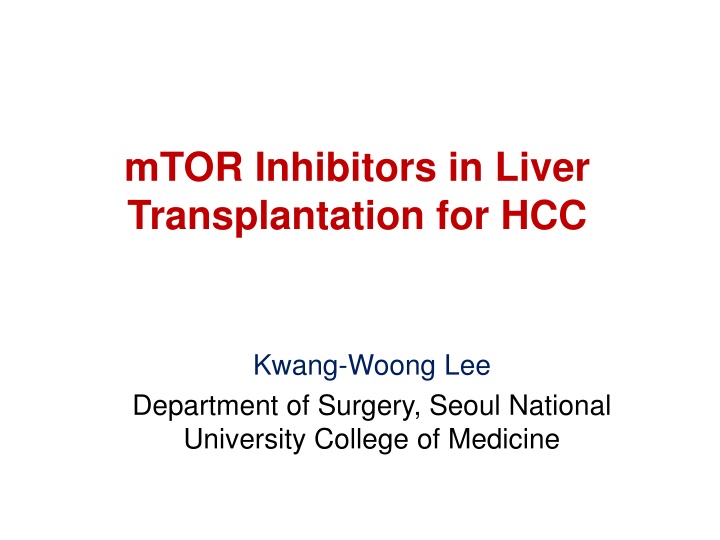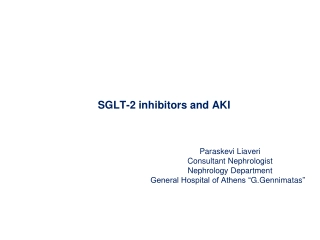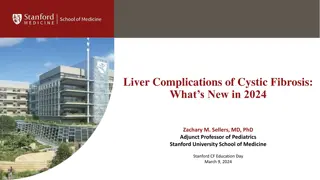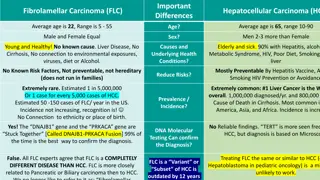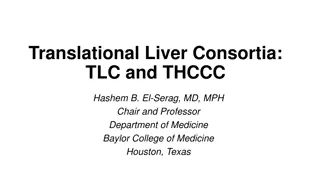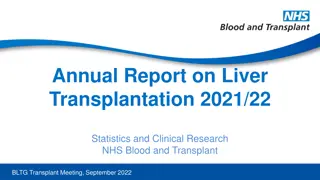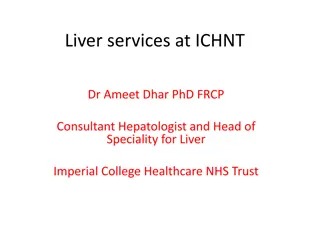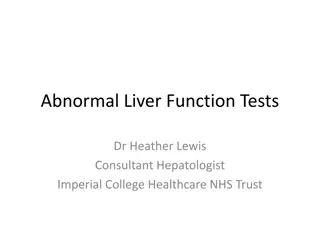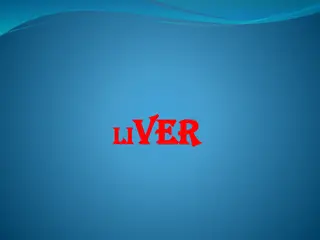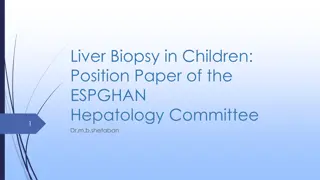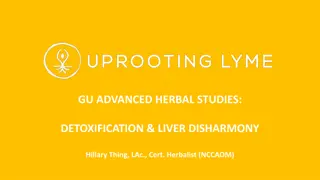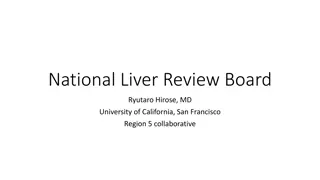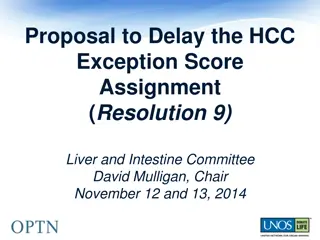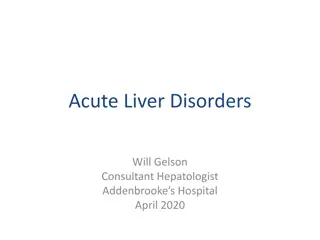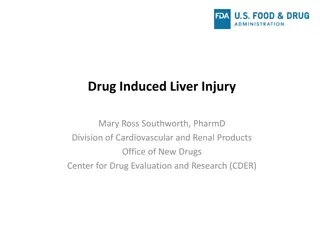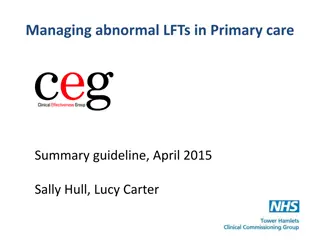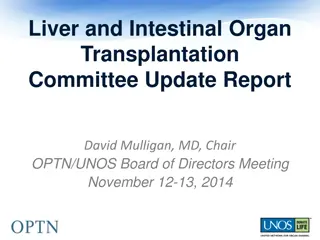mTOR Inhibitors in Liver Transplantation for HCC: Recent Updates and Clinical Trials
Exploring the use of mTOR inhibitors in liver transplantation for hepatocellular carcinoma (HCC), this content presents recent study results and experiences from the Korean population. It discusses the preventive potential of mTOR inhibitors in HCC recurrence based on previous studies and the need for direct comparison studies. Additionally, it provides insights into ongoing randomized clinical trials in different countries evaluating the efficacy of mTOR inhibitors in HCC treatment post-transplantation.
Download Presentation

Please find below an Image/Link to download the presentation.
The content on the website is provided AS IS for your information and personal use only. It may not be sold, licensed, or shared on other websites without obtaining consent from the author.If you encounter any issues during the download, it is possible that the publisher has removed the file from their server.
You are allowed to download the files provided on this website for personal or commercial use, subject to the condition that they are used lawfully. All files are the property of their respective owners.
The content on the website is provided AS IS for your information and personal use only. It may not be sold, licensed, or shared on other websites without obtaining consent from the author.
E N D
Presentation Transcript
mTOR Inhibitors in Liver Transplantation for HCC Kwang-Woong Lee Department of Surgery, Seoul National University College of Medicine
Clinically available m-TORi Once daily Twice daily
Recent updates Recent study results for anti-HCC effect Adequate mTORi regimen Indication Safe initiation time point Safe & effective regimen Experience in Korean population (SNUH)
Recent updates Recent study results for anti-HCC effect Adequate mTORi regimen Indication Safe initiation time point Safe & effective regimen Experience in Korean population (SNUH)
mTORi prevents HCC recurrence in the previous studies * 50 * Proportion of patients with 45 * mTOR inhibitor 40 no mTOR inhibitor * recurrence (%) 35 30 25 * 20 * 15 10 * 5 0 Vivarelli et al 2010 Chinnakotla et al 2009 Zhou et al 2008 Zimmerman et al 2008 Masetti et al 2010 De Simone et al 2013 Fischer et al 2012 Prospective study Limitations of the previous studies the absence of a randomized design concomitant CNI therapy in mTORi group
Clear evidence for anti-HCC effects? Retrospective studies, meta-analyses, and post- hoc assessments of randomized trials uniformly suggested a protective effect of mTORi However, it is unclear whether this benefit is from direct effect of mTOR inhibitors Direct comparison study (mTORi without CNI Vs. CNI without mTORi) is necessary
Randomized Clinical trials in LT for HCC Current Status Director/start Country Study design Contents Process Canada, University of Alberta Complete 2006 (n=70) Norman M Kneteman From 1996 Single group assignment De Novo Sirolimus After transplantation for HCC Complete but no report Germany, University of Regensburg Edward K Geissler, From 2006 Randomized Phase III Sirolimus Vs mTOR-Inhibitor- free Immunosuppression Complete 510 Reported in 2016 Jia Fan From 2007 China, Fundan Univ. Radomized Phase III Sirolimus Versus FK506 HCC Exceeding Milan Criteria Unknown Unknown USA, Baylor Research Institute Baylor Research Institute From 2014 Multicenter, Randomized Phase IV Everolimus+FK Vs. MMF+FK HCC exceeding Milan criteria Recruiting Recruiting Sirolimus+MMF Vs CNI+MMF HCC exceeding Milan criteria (randomized according to AFP 400 & microvascular invasion) Complete recruiting 46 Kwang-Woong Lee From 2010(2008) Korea, SNUH Randomized Phase II Complete in June, 2016 Clinicaltrial.gov
SiLVER study (I) center-specific mTOR inhibitor-free, generally calcineurin inhibitor based mTOR inhibitor Failed to demonstrate an overall benefit of sirolimus in improving long-term recurrence-free survival beyond 5 years after LT
SiLVER study (II) No significant benefit of sirolimus in the high-risk subgroup defined as tumor burden exceeding Milan criteria or salvage LT after resection. A trend for a benefit of sirolimus was observed in low-risk patients with HCC within Milan criteria Limitation - Subgroup (high-risk vs. low-risk) only by Milan criteria - Not consider poor prognostic markers (micro-vascular invasion, tumor grade, or high AFP) when stratification
Sirolimus did not appear beneficial in reducing all-cause mortality SRTR database, retrospective Among the 3,936 included HCC liver transplants, 234 (6%) were sirolimus users. Yanik et al. AJT 2016
Lack of clear long-term benefit Should we abandon altogether the idea of mTOR inhibitors as a means of reducing the risk of HCC recurrence after LT? Not yet Mehta et al. Liver Transpl 2016
Randomized Clinical trials in LT for HCC Current Status Director/start Country Study design Contents Process Canada, University of Alberta Complete 2006 (n=70) Norman M Kneteman From 1996 Single group assignment De Novo Sirolimus After transplantation for HCC Complete but no report Germany, University of Regensburg Edward K Geissler, From 2006 Randomized Phase III Sirolimus Vs mTOR-Inhibitor- free Immunosuppression Complete 510 Reported in 2016 Jia Fan From 2007 China, Fundan Univ. Radomized Phase III Sirolimus Versus FK506 HCC Exceeding Milan Criteria Unknown Unknown USA, Baylor Research Institute Baylor Research Institute From 2014 Multicenter, Randomized Phase IV Everolimus+FK Vs. MMF+FK HCC exceeding Milan criteria Recruiting Recruiting Sirolimus+MMF Vs CNI+MMF HCC exceeding Milan criteria (randomized according to AFP 400 & microvascular invasion) Complete recruiting 46 Kwang-Woong Lee From 2010(2008) Korea, SNUH Randomized Phase II Complete in June, 2016 Clinicaltrial.gov
Recent updates Recent study results for anti-HCC effect Adequate mTORi regimen Indication Safe initiation time point Safe & effective regimen Experience in Korean population (SNUH)
Lack of clear long-term benefit Should we abandon altogether the idea of mTOR inhibitors as a means of reducing the risk of HCC recurrence after LT? Not yet Selective use mTOR inhibitor HCC with up-regulated m-TOR pathway (40- 50% of HCC) In case with high risk of recurrence Mehta et al. Liver Transpl 2016
The up-regulated mTOR pathway is associated with the poor prognosis of HCC mTOR pathway proteins Zhou et al. Med Oncol 2010
High risk of recurrence is good indication of mTORi Risk of recurrence can be stratified by Morphological factors: Milan, UCSF, TTV(Total T umor Volume) Biological factors: AFP, PIVKAII, PET Pathological factors: histology, vascular invasion, histological grade
Risk factors for post-LT HCC recurrence 205 [SNUH (n=168), SMC(n=37)] patients were investigated retrospectively Variable Category Hazard ratio (95% CI) p-value AFP (ng/ml) Reference 0.000 400 >400 5.520 (3.024 10.076) Edmonson-Steiner 1,2 Reference 0.012 3,4 2.249 (1.194 4.234) Tumor size (cm) Reference 0.023 7.0 >7.0 2.213 (1.118 4.381) Tumor number 1-6 Reference 0.002 3.580 (1.603 7.992) 7 TACE responsiveness (necrosis) (%) No TACE Reference Total (100%) 1.386 (0.171 11.226)) 0.760 2.020 (0.830 4.916) 0.121 Partial (60<, 99%) 3.215 (1.549 6.674) 0.002 Minimal ( 60%) Microvascular invasion No Reference 0.035 Present 1.948 (1.048 3.619) Multivariate analysis Park MS, Lee KW, et al JKMS. 2014
Cumulative recurrence rates according to group based on the risk index. Group IV (n=12) Group III (n=33) Group II (n=109) Group I (n=51) 1 year cumulative recurrence rates(%) Mean time to recurrence (Range of months) Group I (n=51) 0 29.5 (18-41) Group II (n=109) 11.6 (3-37) 11.9 Group III (n=33) 10.1 (2-33) 51.5 Group IV (n=12) 4.2 (2-10) 100 Park MS, Lee KW et al. JKMS 2014
Group III & IV will be a good indication of mTORi Group IV (n=12) Group III (n=33) Group II (n=109) Group I (n=51) 1 year cumulative recurrence rates(%) Mean time to recurrence (Range of months) Group I (n=51) 0 29.5 (18-41) Group II (n=109) 11.6 (3-37) 11.9 Group III (n=33) 10.1 (2-33) 51.5 Group IV (n=12) 4.2 (2-10) 100 Park MS, Lee KW et al. JKMS 2014
One month after LT is safe initiation timepoint H2304 & H2304E1
Early initiation of Everolimus Hepaistos Study Nashan, et al. Trials 2015
Early Initiation of Everolimus After Liver Transplantation: A Single-Center Experience Herden et al. Ann Transplantation 2016
Low CNI combination is the most common regimen Study design Group Toso C. et al. 2007 Retrospective Sirolimus+FK or CysA+steroids, n=70 CNI (FK or CysA+MMF+steroid,n=52) Sirolimus (FK or CysA+Sirolimus+steroid, n=45) Zimmerman et al 2008 Retrospective Retrospective case- control Control (FK+MMF, n=106) Sirolimus (Cyclosporine+Sirolimus, n=121) Chinnakotla S. et al. 2009 Control (FK+steroids, n=31) Sirolimus (FK+Sirolimus+ steroids, n=31) Vivarelli M. et al. 2010 Matched-cohort study
Sirolimus + MMF is better than Sirolimus + Tac in direct anti-HCC effect (A) MTT assay (in vitro) (C) Tumor volume in mice (in vivo) 1200 Tumor volume(mm3) 1000 (B) mTOR pathway and TGF- (Western) 1200 800 Control 1000 MMF Siro+MMF 600 Control 800 Siro+Tacro MMF Sirolimus 400 Siro+MMF 600 Tacrolimus Siro+Tacro Sirolimus 200 400 Tacrolimus 200 0 1 week 2 week 3 week 4 week 0 1 week 2 week 3 week 4 week Lee KW et al. Hepatol Res. 2015
mTORi + MMF can be safely applied in clinical setting 12 months 24 months Patients with BPAR (%) 100 100 80 80 60 60 40 40 16.4 16.2 20 14.9 15.1 20 0 0 Everolimus + MPA (n=154) CsA Everolimus + MPA (n=154) CsA (n=146) (n=146) de-novo kidney transplants: an open-label, randomised, controlled trial Budde K et al. Lancet 2011
Second Generation mTORi (mTOR pathway inhibitor) Br J Pharmacol. 2014 Aug
mTORi experience (SNUH, 2007-2015) Kim et al. ILTS2016 poster
Indication of mTORi Sirolimus Everolimus P-value Main diagnosis in the liver transplant, n (%) Carcinoma HBV related HCC HCV related HCC HBV, HCV co-infection related HCC Non-B, non-C HCC Cholangiocarcinoma Liver Cirrhosis (LC) HBV related LC HCV related LC HBV, HCV co-infected LC Alcoholic LC Cryptogenic LC Others HAV related fulminant hepatitis Glycogen storage disease 56 (82.4) 4 (5.9) 1 (1.5) 1 (1.5) 26 (76.5) 2 (5.9) 0.503 1.000 0.482 0.482 0.325 1 (2.9) 1 (1.5) 1 (1.5) 1 (1.5) 2 (5.9) 0.317 0.482 0.482 0.083 0.482 3 (8.8) 1 (1.5) 1 (1.5) 1 (1.5) 0.482 0.482 Kim et al. ILTS2016 poster
Demographics of patients Sirolimus Everolimus P-value Patients, n Age, year, mean (range) Male/female Living donor/Deceased donor 68 34 57.9 (29-77) 56.3 (43-72) 59/9 58/10 30/4 27/7 Initiation of treament after LT, day, mean (range) 220.2 (6-1933) 696.0 (18-2675) 0.000 Duration of treatment, day, mean (range) 567.9 (98-1840) 166.7 (57-451) 0.000 De novo/conversion Concomitant immunosuppressants, n (%) Mono MMF PD FK PD Others PD FK+MMF FK+MMF+PD Trough level, ng/mL First level after initation (7 ~ 14 days) Mean level of three months Mean level of six months 35/33 5/29 0.000 28 (41.2) 29 (42.6) 5 (7.4) 5 (14.7) 5 (14.7) 21 (61.8) 0.003 0.002 0.000 4 (5.9) 1 (1.5) 1 (1.5) 0.045 0.317 0.657 2 (5.9) 1 (2.9) 5.4 (<0.2-22.6) 6.7 (3.1-14.1) 6.7 (31-13.7) 3.8 (<0.2-8.8) 4.1 (2.1-6.8) 4.4 (2.4-5.5) 0.001 0.000 0.000 Kim et al. ILTS2016 poster
Newly developed adverse events No. of events, n(%) Sirolimus (n=102) (n=68) Total Everolimus (n=34) P-value Adverse events Dyslipidemia hematologic problem Leukopenia Anemia Thrombocytopenia Edema 35 (34.3) 23 (22.5) 14 (13.7) 6 (5.9) 3 (2.9) 13 (12.8) 25 (36.8) 16 (23.5) 10 (14.7) 4 (5.9) 2 (2.9) 11 (16.2) 10 (29.4) 7 (20.6) 4 (11.8) 2 (5.9) 1 (2.9) 2 (5.9) 0.461 0.525 0.688 0.607 1.000 0.142 Diabetes melitus 10 (9.8) 10 (14.7) 0 (0.0) 0.028 Stomatitis Hypertension Dermatologic problem Incisional hernia Portal vein thrombosis Acute kidney injury Diarrhea Delayed wound healing Hepatic artery thrombosis Acute cellular rejection 8 (7.8) 8 (7.8) 6 (5.9) 4 (3.9) 4 (3.9) 4 (3.9) 3 (2.9) 1 (1.0) 0 (0.0) 2 (2.0) 6 (8.8) 7 (10.3) 5 (7.4) 4 (5.9) 4 (5.9) 2 (2.9) 3 (4.4) 1 (1.5) 0 (0.0) 2 (2.9)* 2 (5.9) 1 (2.9) 1 (2.9) 0 (0.0) 0 (0.0) 2 (5.9) 0 (0.0) 0 (0.0) 0 (0.0) 0 (0.0) 0.716 0.263 0.661 0.298 0.298 0.599 0.083 0.482 N/A 0.551 *Biopsy proven, but normalized after regimen modulation, no pulse therapy Kim et al. ILTS2016 poster
Summary & Conclusion Recent studies reported negative results, but we need to wait the result of ongoing randomized study Therefore, selective use of mTORi is recommended Tolerable adverse events in Korean population But other potential benefits (renal protection, anti- fibrosis, anti-CMV, etc) should be considered together to find optimal indication for mTORi
